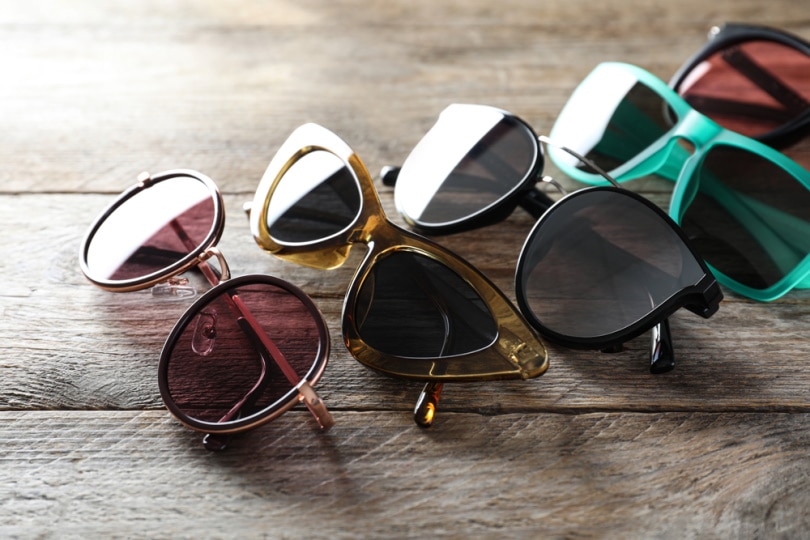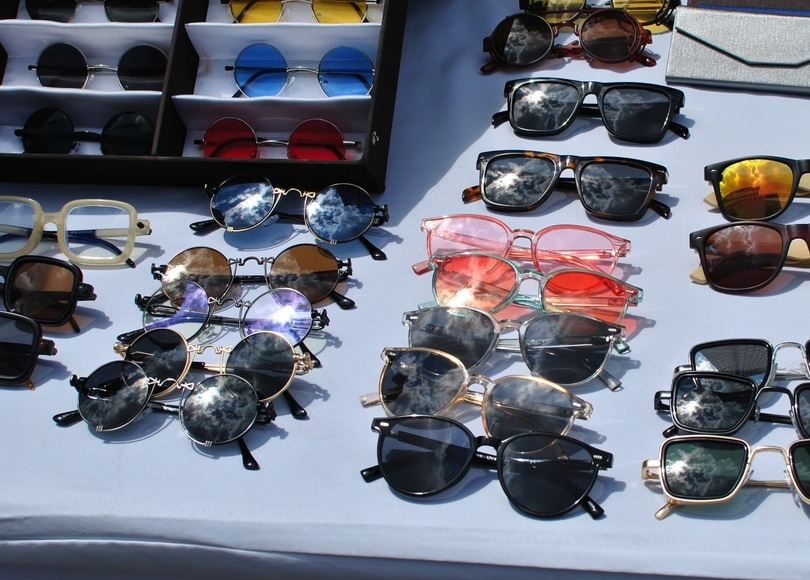How Much Are Prescription Sunglasses in 2024?
Last Updated on

If you rely on eyeglasses to correct your vision, chances are you’ve probably wondered about purchasing a pair of prescription sunglasses. Not only would they protect your eyes from harm, but a pair of sunglasses could also reduce eye strain and prevent headaches.
Before going shopping, you’ll probably want a guideline of how much you can expect a pair of prescription sunglasses to cost. Prices vary depending on several factors, so in this article, we’ll give you a breakdown of average costs.

The Importance of Sunglasses
There are various reasons why investing in a pair of sunglasses is important. Protecting your eyes from the harmful UV rays of the sun, and excessive blue light from both the sun and
electronic screens, can preserve your eyesight, and help to prevent you from getting various eye diseases.
How Is UV Harmful to the Eyes?
Overexposure to the sun’s UV rays over prolonged periods can cause cataracts, growths on your eyelids and the soft skin around your eyes, and photokeratitis, also known as snow-blindness. Too much direct exposure to blue light can be damaging to your retina.

How Do Sunglasses Protect Your Eyes?
Depending on your prescription lens, a good pair of sunglasses could block out the harmful UV rays of the sun and block blue light, thereby reducing the risk of cancer, and helping to prevent the growth of cataracts.
Subscription sunglasses would also:
- Reduce glare (especially helpful when driving)
- Block out blue light from the sun and digital screens
- Reduce eyestrain
- Reduce the risk of light-induced migraines
How Much Do Prescription Sunglasses Cost?
The cost of your prescription sunglasses will differ depending on several factors. Designer frames will cost more than an unbranded pair. Online stores like Zenni sell prescription sunglasses starting from $15.95. On the other end of the spectrum, this pair of Cartier sunglasses from Mott Street Optical in New York starts from $3,195.
On average, a good pair of prescription sunglasses will cost between $100 and $500. Places like Warby Parker and Lenscrafters sell prescription sunglasses with prices starting from around $195.
Other factors that will affect the price of your subscription sunglasses are the features and quality of the lenses you pick. Polarized and UV lenses can increase the cost of your sunglasses by more than $100.
Other features and add-ons that can increase the cost of your lenses include anti-scratch coating and anti-reflective coating.

Additional Costs to Anticipate
The cost of your sunglasses will vary depending on the requirements and complexity of your prescription. The most common prescription lenses include:
- Single-vision lenses — Used for astigmatism, nearsightedness, and farsightedness, these types of lenses have one power grade. They are the most commonly prescribed, and also the cheapest prescription lenses.
- Progressive lenses — Also called multifocal, these lenses incorporate more than one prescription, eliminating the need for more than one pair of sunglasses. Progressive lenses can increase the cost of your lenses by around $75.
- Bifocal lenses — Bifocal lenses incorporate two prescriptions, with a line separating them. Generally useful for being able to see nearby for tasks like reading, and far for tasks like driving. Bifocals can increase the cost of your lenses by around $50.
- Trifocal lenses — These allow you two see close, midrange, and far, but usually can increase the cost of your lenses by around $100
Lens Thinning and Lightening
If your prescription is powerful, your lenses may get very thick and heavy. In this case, they may benefit from a thinner and lighter material that still allows for the same power. These lenses often cost more, but the benefits could be worth it. Aside from feeling lighter and looking better, they also reduce the magnification or minification of the eyes, resulting in a more flattering look.

How Often Should I Buy New Prescription Sunglasses
As you age, so do your eyes, and with that, your prescription may no longer be suitable. For this reason, it’s good to go for an eye exam once a year, or at least once every two years.
As for sunglasses, they have expiration dates after which they will no longer be as effective at protecting your eyes from UV rays as they once were. When the UV coating on your sunglasses is scratched or cracked from old age, it’s time to get a new pair of sunglasses.
On average, sunglasses remain effective for around two years, however, this will be less if you’re using them in bright sunny environments, for example, the seaside, or somewhere with a lot of snow, for prolonged periods.
Your sunglasses may last longer if you’re only wearing them occasionally, but it’s important to remember that cloud cover does not protect your eyes from UV rays. You should wear your sunglasses even when the sky is overcast.
Does Vision Insurance Cover Prescription Sunglasses?
In most cases, vision insurance will cover prescription sunglasses because prescription sunglasses are used to correct your vision as well as offer protection from sun exposure. However, it’s always important to check with your insurance provider to make sure that prescription sunglasses are included in your coverage.
If you are eligible for FSA or HSA, you may be able to combine this with your vision insurance, potentially decreasing the overall amount you spend on your prescription sunglasses.
Prescription sunglasses can be a heavy additional cost, which is why some stores also offer pay-over-time options through companies like Affirm, which would help you split the cost over several payments.

Other Ways to Care for Your Eyes
Wearing sunglasses is a great way to protect your eyes from exposure to the sun’s harmful rays, but there are additional steps you can take.
- By wearing a broad-brimmed hat or cap, you will dramatically reduce the UV light that enters your eyes.
- Avoid looking directly at the sun — doing so can cause irreversible damage to your retina.
- If you’re working with a computer, take a break every 20 minutes to focus your eyes on a distant object for as little as one minute. This will reduce eyestrain.
- Switching to a night/dark mode when browsing the web or using apps will also reduce eyestrain.

Conclusion
Wearing a good pair of UV-coated sunglasses is vital to maintaining healthy eyes. With so many stores and options available, a pair of prescription sunglasses don’t have to be expensive either. Prescription sunglasses can be purchased for as little as $20, or as much as $500 for a designer pair.
When it comes to prescription sunglasses, there are many stylish unbranded, and designer options to choose from, but whatever you go with, it’s important to ensure that it will give your eyes adequate UV protection.
Featured Image Credit: New Africa, Shutterstock
Table of Contents
- The Importance of Sunglasses
- How Is UV Harmful to the Eyes?
- How Do Sunglasses Protect Your Eyes?
- How Much Do Prescription Sunglasses Cost?
- Additional Costs to Anticipate
- Lens Thinning and Lightening
- How Often Should I Buy New Prescription Sunglasses
- Does Vision Insurance Cover Prescription Sunglasses?
- Other Ways to Care for Your Eyes
- Conclusion
About the Author Cheryl Regan
Cheryl is a freelance content and copywriter from the United Kingdom. Her interests include hiking and amateur astronomy but focuses her writing on gardening and photography. If she isn't writing she can be found curled up with a coffee and her pet cat.
Related Articles:
How to Clean a Refractor Telescope: Step-by-Step Guide
How to Clean a Telescope Eyepiece: Step-by-Step Guide
How to Clean a Rifle Scope: 8 Expert Tips
Monocular vs Telescope: Differences Explained (With Pictures)
What Is a Monocular Used For? 8 Common Functions
How to Clean a Telescope Mirror: 8 Expert Tips
Brightfield vs Phase Contrast Microscopy: The Differences Explained
SkyCamHD Drone Review: Pros, Cons, FAQ, & Verdict
